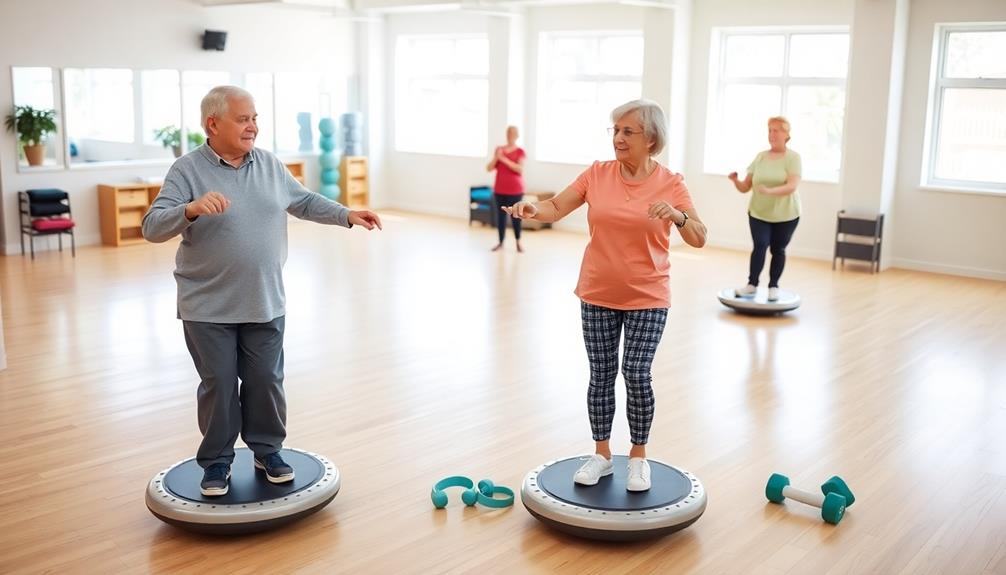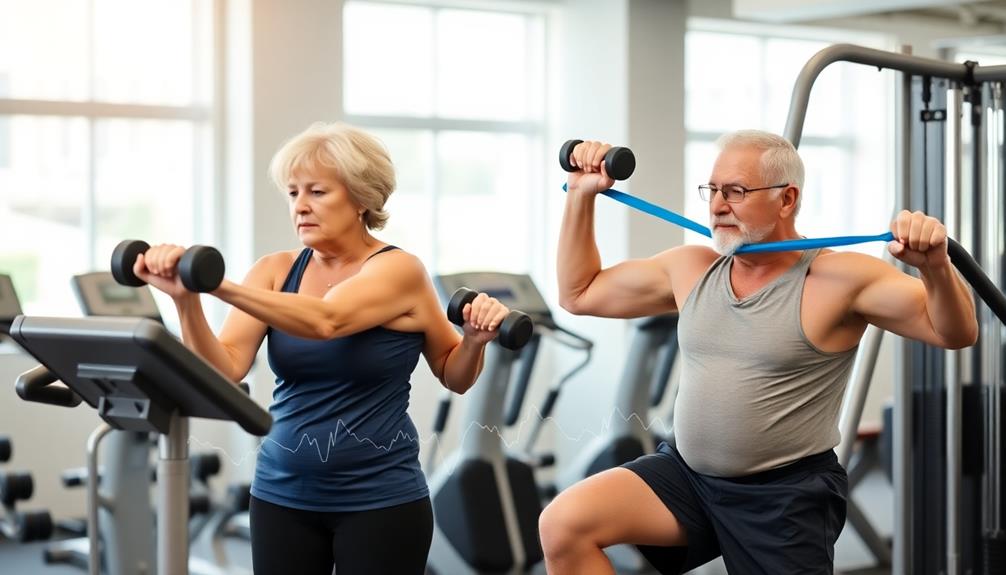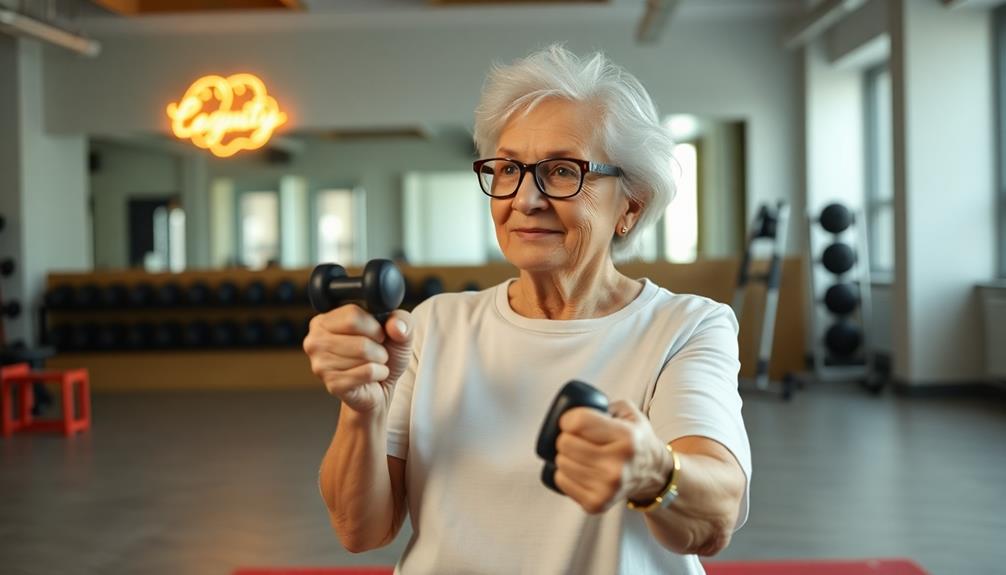Resistance training offers numerous benefits for older adults. It combats age-related muscle loss, enhances bone density, and improves balance and coordination. By engaging in regular strength exercises, you'll boost your metabolism, aiding in weight management and improving insulin sensitivity. Weightlifting and resistance band exercises stress your bones, promoting strength in vital areas like the spine, hips, and wrists. Additionally, this type of training supports cognitive function by increasing blood flow to the brain and stimulating mental activity. Start with light weights and progress gradually, focusing on proper form to avoid injury. The following sections will provide more detailed insights into these advantages.
Core Insight
- Combats age-related muscle loss (sarcopenia) by building and maintaining muscle mass.
- Enhances bone density, particularly in the spine, hips, and wrists, reducing fracture risk.
- Improves balance and coordination, reducing the risk of falls in older adults.
- Boosts metabolism and aids in weight management by increasing lean muscle mass.
- Supports cognitive function, enhancing memory, focus, and overall brain health.
Combating Age-Related Muscle Loss

Losing muscle and strength is a normal part of aging. This process, called sarcopenia, can start in your 30s and speeds up after 50. But you can fight back against muscle loss. Resistance training is a great way to combat sarcopenia. Using targeted compression can also help your muscles recover and perform better, along with your resistance training.
Strength exercises will help you grow and keep muscle. This type of training doesn't just maintain the muscle you have; it can actually help you build new muscle. You'll also make your bones stronger, improve your balance, and speed up your metabolism.
Begin with exercises that use your own body weight or light weights. Slowly increase how hard the exercises are as you get stronger. Do exercises that work many muscle groups at once, like squats, push-ups, and rows. Try to do these exercises two to three times a week, and give your body time to recover between workouts.
Enhancing Bone Density

Older adults can make their bones stronger by doing resistance training. As people age, their bones get weaker and are more likely to break. Lifting weights or using resistance bands puts stress on the bones. This stress makes the body build new bone, so the bones get stronger.
Resistance tubes are easy to use and you can take them anywhere. They come in different weights from 2 lbs to over 40 lbs. It's important to do exercises that work the spine, hips, and wrists. These are the areas where breaks happen most often.
Start with light weights and slowly add more weight as you get stronger. Try to do resistance training two or three times a week. Always take at least one day off between workouts to rest. Using the right form is important to avoid getting hurt and to get the most benefit. If you've never done resistance training before, think about working with a trainer. They can help you make a safe and effective plan.
Improving Balance and Coordination

Resistance training makes your bones stronger and helps you balance and coordinate better as you get older. When you do strength exercises regularly, you'll be more stable and less likely to fall. Check out this table to see how resistance training improves your balance and coordination:
| Exercise Type | Balance Benefits | Coordination Benefits |
|---|---|---|
| Squats | Better stability | More leg control |
| Lunges | Improved balance | Increased body awareness |
| Deadlifts | Stronger core | Better posture |
| Planks | Better body alignment | Enhanced muscle teamwork |
| Leg raises | Stronger lower body | Better awareness of space |
Boosting Metabolism and Weight Management

Resistance training is a great way to boost your metabolism and manage your weight. As you get older, your metabolism slows down, but strength exercises can help fight this. Building lean muscle makes your body burn more calories, even when you're resting. The protein in grass-fed whey also helps your muscles recover and grow.
When you lose weight, resistance training helps you keep muscle and mainly lose fat. This is important for a healthy body. It can also make your body respond better to insulin, which helps control blood sugar and lowers your risk of type 2 diabetes.
To get the most benefits, try to do resistance training two to three times a week. Choose exercises that work several muscle groups at once, and gradually use heavier weights as you get stronger.
Supporting Cognitive Function

Strength training isn't just good for your muscles; it's great for your brain too. Studies show that lifting weights regularly can boost your memory, focus, and ability to make decisions. When you work out with weights, you're giving your brain a workout at the same time. Your brain gets more blood, oxygen, and nutrients, which helps it grow new connections. Just remember to drink plenty of water during your workouts, especially when it's hot out. Staying hydrated will help you think clearly and perform at your best.
As you keep up with your strength training, you'll probably notice that it's easier to concentrate and tackle problems. Plus, learning new exercises is like a mental puzzle that keeps your brain in top shape. This can help protect you from memory loss and brain diseases as you get older.
Frequently Asked Questions
How Often Should Older Adults Engage in Resistance Training?
You should aim to do resistance training at least twice a week. It's best to space your sessions out, allowing for rest days in between. Start slowly and gradually increase intensity as you build strength and confidence.
Are There Specific Exercises to Avoid for Seniors With Arthritis?
You should avoid high-impact exercises like jumping or running if you have arthritis. Steer clear of movements that cause pain, such as deep squats or heavy lifting. Instead, focus on gentle, low-impact exercises that don't stress your joints.
Can Resistance Training Help Manage Chronic Conditions Like Diabetes?
Yes, resistance training can help you manage diabetes. It improves your insulin sensitivity, lowers blood sugar levels, and increases muscle mass. You'll also burn more calories, which aids in weight management—a vital factor in controlling diabetes.
What Equipment Is Necessary for Seniors to Start Resistance Training?
You don't need much to start resistance training. Begin with bodyweight exercises like squats and push-ups. Add resistance bands or light dumbbells as you progress. Always consult your doctor before starting a new exercise routine.
How Long Does It Take to See Results From Resistance Training?
You'll start feeling stronger within a few weeks, but visible changes typically take 8-12 weeks. Consistency is key. You'll notice improvements in strength, balance, and energy sooner than physical changes. Keep at it, and you'll see results!

